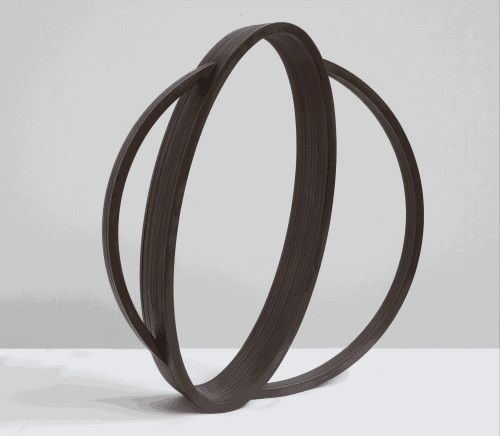Ellipses are the perfect expression of dynamism and beauty.– Nigel Hall
Should one just stand reverently before them? When it comes to Nigel Hall’s sculptures, that’s not the best way to appreciate them. Instead, you must walk all around them, exploring them from every angle. These are works of art brought to life by the experience of movement. They embody the perception of shape-shifting through a change in perspective, as one experiences when walking or driving past a stationary object, and feeling a sense of movement innate within it.
A good example of this sensation is his work Through Clouds, which gives the exhibition its name. Three large corten steel ellipses, joined one to the other as well as intruding one into the other, seem to change shape with every step you take around them, the way a cloud formation or landscape shifts as you walk by – or in the case of Through Clouds, as you float past, a passenger flying by in a glider.
British artist Nigel Hall has an affinity for this particular shape. “Ellipses are the perfect expression of dynamism and beauty,” he says. “And we are surrounded by them, all the time and everywhere. A coffee cup, a coin, the tyre of a car: in actual fact they’re all perfectly round. But most of the time, we perceive these things as elliptical shapes, sometimes more rounded, sometimes flatter, depending on the angle we’re looking at them from. But the oval is not only a matter of perspective. It’s also an integral aspect of the cosmos. The stars and planets move in paths that are oval in shape. We live our entire lives in an elliptical orbit.”
The oval in Nigel Hall’s work functions as a geometric representation of movement, and it not only applies to his bronze, wood or corten steel sculptures, but also to his works on canvas. In these two-dimensional images, charcoal drawing and acrylic painting are combined to form motifs that seem strict in terms of their formal shape yet at the same time are surprisingly mysterious: an arrangement of circles and ellipses that seem to dance with, and around, each other, like snapshots from the choreography of cosmic movement. And yet despite their cool, reduced aesthetics, they still leave plenty of room for personal interpretation. For example, a work like 1895/C2 (Mourning Moon), with its dominant shape a dark circle accompanied by a faint yellow oval, expresses a real sense of melancholy – and not only because of its title.
Born in 1943, Nigel Hall is one of the best-known contemporary British artists. His works can be found in numerous international museums and private collections, among them the Tate Gallery in London, the Neue Nationalgalerie in Berlin, the National Museum of Art in Osaka, and the Museum of Modern Art in New York. He has been a Lecturer at the Royal College of Art and ran the MA sculpture course at London’s respected Chelsea College of Art and Design. In 2003 he was named a member of the Royal Academy of Art. Nigel Hall lives and works today in London.
It is a great honour for us to be able to present Nigel Hall’s work here on Talstrasse in Zurich, his fourth solo exhibition at the gallery.
Alice Henkes

